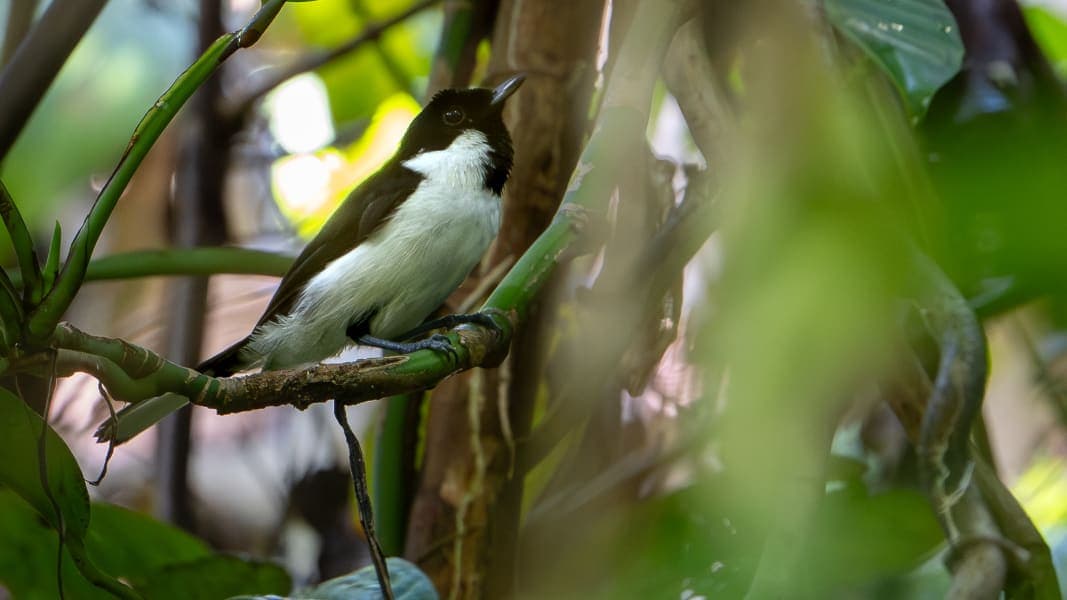Josh Bergmark / 1 Oct 2025
Josh Bergmark tells the story of photographing Vella Lavella Monarch in the Solomon Islands, one of only a small handful of birds that have never before been photographed. Documented records of species like the Vella Lavella Monarch provide the basis for the Search for Lost Birds list.
At the south-western edge of the Solomon Islands lies Ranongga. Uplifted by tectonic action like most of the neighboring islands, it is no bigger than the city of Boulder in Colorado. The island is separated from neighboring Vella Lavella by just 8km of ocean, and this from the next largest island of Kolombangara by 24km of ocean. Powerful geological forces are still at work, with a large earthquake in 2007 lifting the island more than 3m and turning beachfront villages into raised lookouts! One such settlement, Kongu, was previously a dangerous place to land boats on days with any significant swell. Now the raised sea floor has formed a perfect natural harbor which provides easy access for the locals.
A group of birdwatchers with Ornis Birding Expeditions journeyed here in early July 2025, and were enthusiastically greeted by the youngest son of Aaron Kumana, John Kennedy Kumana. We paid respects at Aaron’s grave, a legendary man who helped save future US president John F Kennedy and his stranded platoon in 1943.
Our primary reason for visiting was to access the higher forests of the island, which few ornithologists have recently explored. After climbing steeply through gardens and scrub under hot sun, a beautiful descent into the cooler valley of native vegetation provided welcome relief.
We had been directed here by a young boy with a slingshot, who recognized the birds we had shown in the field guide back at the coast. John was the first to spot a large bright yellow bird creeping in the viny tangles, a striking male Oriole Whistler (ssp melanonota, which as far as we know had never been photographed before) began singing as we marveled at his truly distinctive plumage.
This province, known as Western Province, is a fascinating melting pot for avian evolution. The main nine islands all isolate endemic forms of small forest birds variably split by taxonomists due to their distinctive plumages which blend complexly between the islands. Channels of water barely 4km wide in some places act as barriers for these sedentary passerines and limit gene flow. However, weak natural selection pressures hinder uniform plumage evolution. As a result, unlike most birds around the world, adult Oriole Whistlers here often differ in appearance within, as well as between, island populations.
Males from Kolombangara (ssp centralis) show variably yellow collars between neighboring territories, while those on Ranongga are known to sometimes have differences in thickness of their black breast bands. Yet, each subspecies always closely matches the overall “field guide” look expected from the forms on each island. This instability is probably in part why the Oriole Whistlers remain treated as a single species across the Solomons. There are few formal field observations of some taxa, especially on Ranongga where vocalizations are poorly known, and this taxonomic arrangement may change in the future!
We continued birdwatching, still looking for our main target, the Vella Lavella Monarch. Thin mournful whistles alerted us to its presence, but the bird was shy. Finally, we glimpsed a monarch through the foliage and recorded its song while snapping a few photos, which are the first of this species uploaded to the Macaulay Library and likely the first-ever taken of this recently split species. From the ~11,000 birds in the world, only 82 have never been photographed alive (as of the time of this writing) and the Vella Lavella Monarch was one of only seven “unphotographed” birds that are not on the lost birds list.
Until recently considered conspecific with the Kolombangara Monarch, the Vella Lavella Monarch is found on its namesake Vella Lavella island as well as on Ranongga. Our bird on Ranongga (ssp ganonggae) had a white neck completely separating the small black throat from the black and white wings, while the nominate birds we recorded and photographed the next day on Vella Lavella (ssp nigrotectus) had a more extensive white cheek and no white at all on the wing. Despite these marked differences between the two forms, it appears that their respective island plumages are much more stable than the whistlers and show minimal variation.
Regardless of where humans construct lines around species, evolution presses on in the Western Isles of the Solomon Islands.
Returning to the coast, we showed our photos to a few dozen intrigued residents back in Kongu. It was surprising to learn that, aside from two or three hunters who regularly ventured up into the primary forests, none of the people with whom we spoke knew that these two birds existed on their island. One of the kids who had accompanied us humorously acted out to his peers how we had been sneaking through the forest and raising cameras at the birds as they shot back and forth across the track. While many had been present earlier in the day when we showed the field guide illustrations around, it was clearly more exciting and relevant for everyone to see these actual photos. A very powerful tool for engaging communities indeed, and we assured the residents that more birdwatchers would visit their forest in the future!
Josh Bergmark is the director of Ornis Birding Expeditions, a company which specializes in taking birders to the most challenging destinations on the planet. Josh’s Ornis tours have rediscovered the Mussau Triller and Bougainville Thicketbird in addition to getting some of the first photos and only recent records of birds like Moustached Kingfisher, Manus Dwarf-Kingfisher, and others. Ornis Birding Expeditions and American Bird Conservancy support the Ornis x Lost Birds Expeditions Grants for Young Birders. To apply, visit: https://www.ornis-birding.com/grants.
